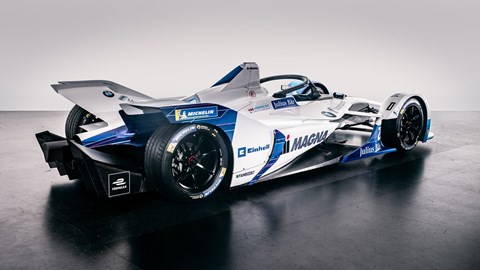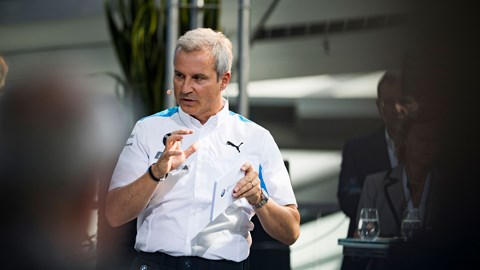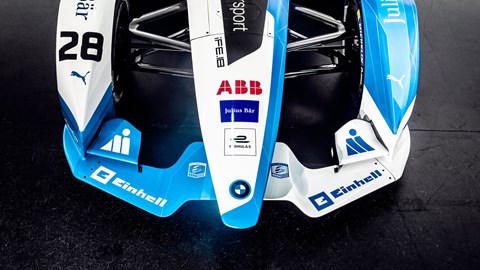► BMW joins Formula E in season 5
► After one year of running with Andretti
► Sims and Da Costa will drive the iFE.18
Formula E may have started back in September 2014, but next season represents the true beginning of the all-electric racing series. A radical new chassis and aero kit means Gen 2’s cars will certainly look quicker, while revised technical regulations mean they’ll actually be faster – and their batteries will last an entire race, too.
The new rules have already had a huge impact for the sport, with major OEMs such as Jaguar, Nissan and now BMW set to join the all-electric racing series. Mercedes intends to join in 2020, too. But what’s the technology powering the new series, why is it like catnip to OEMs, and just how strong is the road to race connection? CAR attended the launch of BMW i’s debut Formula E car, the BMW i.FE 18 to find out.

BMW iFE.18: the lowdown
You’re looking at the first single-seater racing car from BMW since its Sauber stint in Formula 1. Last year, BMWs had something of a dry-run, partnering with the well-established Andretti team, but this year, it’s majorly stepped up its involvement in the team.
The staff remain, with Andretti team principal Roger Griffiths still very much in charge, but the drivers are different: Alexander Sims and Antonio Felix da Costa have both been drafted from BMW’s motorsport programs.

Interestingly, the logos you’ll see on team members and the cars next year won’t just have BMW or Andretti badges, either – they’ll feature BMW i logos, too, and that reflects one of the main draws of Formula E right now.
The marketing spin
After launching the BMW i cars earlier this decade, the Bavarian car maker has arguably squandered its lead, simply revising its i3 and i8 with modest upgrades and better battery packs, while rivals such as Mercedes-Benz and Audi launch their first full electric production cars – and openly plan EV model ranges.
BMW needs to get things back on track, and along with the iX3 and iNext, Formula E will be a big part of that. The car maker has dabbled with the electric series from the very beginning, supplying both the medical and safety cars with trick i3s and i8s, but running a team – and potentially winning with one – will put BMW’s i brand front and centre on EV’s biggest stage.
Tell me about the Formula E tech?
A new chassis and aero package made by Dallara is identical across teams. It generates considerably more downforce thanks to that mighty wing and rear diffuser, and there’s a unique Halo device. Oh, and it also looks considerably cooler than last year’s cars, straddling LMP1 looks and open-wheeled racers, a bit like Formula One meets Le Mans hybrid.
The new battery
Underneath, a new battery represents the most important change for the 2018-19 Formula E racers. Standardised across teams and built by McLaren, the new cell will have enough charge to complete a full race without stops – and that’s important from a brand and messaging point of view.

After all, if you’re trying to prove range is no longer an issue for EVs, having to swap cars mid-race before the batteries die presents pretty poor optics. ‘It was fun to watch, but wasn’t necessarily the message we wanted to pitch out customers,’ a BMW official tells us. We agree.
‘If the fuel is the same for everybody, and you still have a combustion engine, it’s just down to what you do with your combustion engine. It’s the same over here,’ BMW’s director of motorsport Jens Marquardt tells CAR magazine.
‘With the new battery, the current that comes is the same for everybody, what you do downstream of that is up to you,’ he continues. ‘How quickly you get it into your electric motor, how quickly you go between charge and regen, and deliver the power to the unit, how efficient you are in that respect; it’s all up to each team.’

So, while the chassis and aero package are a constant on all cars in Formula E Season 5, pretty much everything underneath and behind the driver can be developed by teams – apart from the battery, of course. That means efficiency, weight and cooling will be the key areas of development for Formula E cars, and that ties in perfectly with the challenges faced when developing electric road cars.
Wait, why were the rules so rigid?
First conceived during four years of Red Bull domination in F1, and first run alongside a similarly controlled Mercedes-dominated era, the last thing the fledgling EV series needed was one team crushing the others.
Keeping components identical across the grid helped stop that happening, but for the past few years different areas of the car have been opened up to development. Now with major manufacturers eager to showcase their roadgoing EV tech, it’s time to give them a proper marketing and R&D platform.
So what can teams actually do themselves?
‘The hardware, electric motor, inverter, the packaging inside the rear end of the car, the rear axle technology, the rear suspension kinematics going into the standard hubs, is all BMW,’ explains BMW’s director of motorsport Jens Marquardt. ‘The powertrain at the heart is BMW, and the cooling is as well – as it’s specific to your powertrain – and the rest of the car is the same,’ he adds.

BMW is serious about road to race, too – and even uses the same staff for both projects. We’re told many of those involved in BMW’s i cars were drafted over to the Formula E project – and are now back on road projects.
It’s one of the reasons why BMW compares the iFE’s powertrain to that of the i3’s, and although it’s a race car, it’s still impressive to see the advances in tech between the varieties. For example, BMW’s season 5 racer has 100% more power than the BMW i3 on which it’s based, along with 40% less volume and a 50% weight saving.
Software plays a role too
Marquardt tells CAR that unlike F1, which features an ongoing stream of development throughout the year, the hardware of the Season 5 cars is homologated before the championship starts. Interestingly, BMW also told us the FIA was surprised at how much ballast it could run…

However, while the hardware is frozen, the software itself is not – and that represents another huge part of EV performance. BMW says it’s adapted the software from its existing EVs for the Formula E car, so the programs which dictate how much energy to save and how much to use are actually are incredibly robust and essentially production spec. That means there’s every chance of development going the other way in future, too.
Doing the homework
BMW’s involvement with the Andretti team in the 2017-18 may also provide a serious helping-hand. Because of the one-day format of Formula E (where both qualifying and race day are on Saturday) it’s important to optimise the new cars as soon as possible. Because BMW competed last year, it already has all the data it needs to start with a useful baseline.
‘You have an advantage if you have run the tracks with the previous cars – which our team has – as then you just transfer that into the new package and quickly go to finding the optimum,’ Marquardt tells CAR. ‘Because it’s a one-day event, the speed in finding the optimum is really the key to success. That’s why we teamed up with Andretti, to get direct information into the development process but also to learn basically hands-on what it takes.’
Season 5 of Formula E begins at the Ad Diriyah ePrix in Saudi Arabia on 15 December 2018
Further electric car reading
The best electric cars and EVs on sale today
How much does it cost to charge an electric car?
The best hybrids, plug-ins and PHEVs
Wireless electric car charging